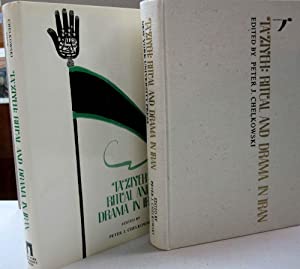Taziyeh: Ritual and Drama in Iran
Ta'ziya: Ritual and Drama in Iran is a book about the Taziya written by Peter J. Chelkowski.
 | |
| Author | Peter J. Chelkowski |
|---|---|
| Language | English |
| Genre | Ritual and Drama |
| Published | 1979 |
| Publisher | New York University Press |
| Pages | 288 |
About the author
Peter J. Chelkowski, is the prominent Polish orientalist teaching at New York university, who has written extensively about the development of religious dramas in Iran.
About the book
The original book "Ta'ziya: Ritual and Drama in Iran", which is in the English language, includes articles presented to the International Ta'ziya Assembly. This assembly was held with the presence of theater artists, musicians, historians and sociologists in the summer of 1355 (1396 AH, 1973 CE) in Shiraz.
This book was translated by Dawood Hatami in Persian and has been published in 1000 copies at one time by Samat Publications. In view of the translator, "The present book is a brand new and beneficial work, at least for those who are familiar with the performing arts. New in the sense that, it is undoubtedly, the first academic work in its own realm; and beneficial because of the different and diverse dimensions of the subject matter"
The collector also mentions in the introduction, "The articles present in this book thoroughly trace the origins of the mourning ceremony of Muharram up to the level of the display and theater"
The content of the Book
Some parts of the book are researches to find the pre-Islamic roots of the Ta'ziya, while other sections either compare the Ta'ziya with medieval depictions of the tragedy of Jesus Christ or describe the holding of Imam Hussain in the neighboring countries of Iran, Turkey, the Indian subcontinent and Pakistan".
The book's articles list the historical, anthropological, artistic, literary, musical aspects of Ta'ziya along with its origins and changes. The scope of this research is beyond Iran, but it focuses on Iran. Among the various aspects of the Ta'ziya, much of the attention has been paid to the artistic aspect and least of all to the evaluation of the Ta'ziya narratives and the extent to which they are in compliance with history. A part of information in the book is incorrect, stemming from the authors' unfamiliarity with history, which at times, is correctly reminded by the translator.
The list of articles and their authors' names are:
- Ta'ziya: Indigenous Avant-Garde Theatre of Iran, Peter J. Chelkowski;
- Analysis of the Ta'ziya of wedding of Qasem (AS), Sadiq Humayuni;
- Cultural dimensions of performance conventions in Iranian Ta'ziya, William. O. Beeman;
- Semiological aspects of the Ta'ziya, Andrzej Wirth;
- Literary and musical developments in Ta'ziya, Anayatullah Shahidi;
- Ta'ziya and the related arts, Samuel R. Peterson;
- Ta'ziya and pre-Islamic mourning rites in Iran, Ehsan Yarshater;
- Ta'ziya and its philosophy, Mayel Baktash;
- Presentation of Ta'ziya: Preliminary information for comprehensive research , Jean Calmard;
- A few considerations in comparison between the Iranian Ta'ziya ceremony and the depiction of the sufferings of Christ in the Middle Ages Christianity in the West, Enrico Fulchignoni;
- The impact of European theater and the influence of its theatrical methods in Ta'ziya, Mohammad Jafar Mahjoob;
- Ta'ziya from the viewpoint of the Western theater, Parviz Mamnoon
- The Literary Resources of Ta'ziya, L.P. Elwell-Sutton;
- Stereotyped imagery in the Ta'ziya, William L. Hanaway
- Elegy in the Qajar period, Zahra Iqbal (Namdar);
- Marsiyeh in Sindhi poetry, Annemarie Schimmel;
- Ta'ziya ceremonies in India, Husain Ali Jaffri;
- Shi'ism and Ashura in Lebanon, Michel Mazzaou;
- The Muharram observances in Anatolian Turkey, Metin And;
- Bibliography, Chelkowski.
Selected part of the book
In the Safavid era and in the first years of the 16th century, the martyrdom of Imam Hussein had become a patriotic practice. In most of the articles in this book as well, the core of the Ta'ziya is considered to be the heroic martyrdom of Imam Hussein, the son of the Prophet's daughter and Imam Hussein is considered to be the focus of all actions that everything revolves around his decisions, thoughts, desires and words.
Imam Hussein, alone in the burning desert, occasionally laments his terrible loneliness and summons his grandfather Prophet against the companions who have left him alone for fear of death. There are scenes in the Ta'ziya where one can identify the popular and the hated characters, however some articles do not introduce the characters as completely white or absolutely black. The majority of the writers of the articles view the language of the Ta'ziya as folky. Almost all articles point out that all the Ta'ziya are similar in subject matter but differ in design and construction, and this difference can be seen in their wording.